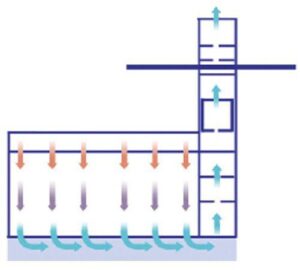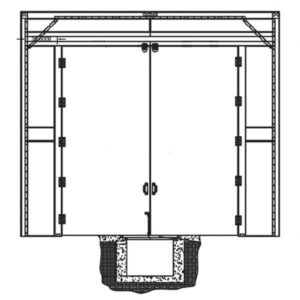A pitted downdraft paint booth serves as a controlled environment where paint can be applied on a variety of manufactured products. This may include vehicles, boats, airplanes, parts, and furniture to mention just a few. Despite the exact size, application or given industry the product being painted falls under, the basic structural design of these machines tends to be the same. A spray booth may be completely enclosed or come with an open front. These products might also be either configured as standalone equipment or be integrated into a conveyorized finishing system. Generally speaking, there are diverse mitigating reasons for using pitted downdraft paint booths in industrial grade manufacturing operations.
These models make sure paint jobs can be performed quicker, safer and even cleaner. The key advantage of this sort of product is it ensures paint overspray is at all times contained and efficiently expelled from the workspace.
This goes a long way in keeping industrial workers and the surrounding environment safe from the risk of contamination. To this end, such a product confines the application of hazardous industrial materials in a more controlled setting. For instance, this can ensure dangerous overspray cannot trigger fires or explosions. A pitted paint booth may as well regulate air fuel/mixture to guarantee combustible combinations never happen. Paint booths also facilitate a cleaner environment in which manufactured products can be painted.Besides this, spray booths are also noted for substantially improving the quality of professional grade paint jobs. These machines present a workspace that is devoid of contaminants in order to achieve top quality paint jobs. As such, prior to air being introduced in such a space, it is first filtered by high efficiency filters. In its turn, this deters dirt or even dust particles from gaining entrance into the workspace, and ultimately ending up on the paint job.
Cleaner paint jobs as well equate to significant reductions of reworks, which will always save industrial businesses valuable time, labor and money.
One of the key components of a spray booth is what are known as air makeup units (AMUs). AMUs set to work by pressurizing these machines and ensuring air flows continuously all across the booths. Apart from the basic paint spraying modes, some of these products may come complete with cure modes, which enable paint to adhere and dry to the object being painted much quicker. On a parting shot, making use of code-compliant paint booths is a critical prerequisite to adhere to local, state and national safety codes when it comes to protecting industrial workers and the environment at large. Let us now take a more detailed look at the pitted downdraft paint booth, and what makes it stand out from the rest of the pack.
Generally speaking, there are plenty of important factors one has to reflect on before settling for any industrial spray booth model, especially if it is for a production facility. Among other essential variables, you will have to look at the 2 options of the practicability of either pitted downdraft booths or non-pitted booths. To this end, pitted models are widely regarded to be some of the most superior products currently on the market. This is especially the case when it comes to fully fledged industrial production facilities. In these sorts of downdraft booths, the air flow is specifically designed to efficiently fashion an envelope, which surrounds the particular object being painted.

In this given configuration, the air is relayed from the ceiling in a downward path that encompasses the painted object and is expelled underneath it. While the excessive overspray and any contaminants present in the workspace are drawn downwards to the pit via a number of filters, prior to being released into the atmosphere.
For optimum performance in a full sized downdraft spray booth, there is a critical need for a proper pit for the airflow path. These kinds of pits, on their part, may be cut directly into concrete and are built to run along the whole length of the booth. Ideally, concrete pits are universally considered to be the gold standard, so to speak, for pitted downdraft paint booths. Concrete pits may be effortlessly and conveniently integrated into a wide variety of architectural designs of new production shops or if necessary, they can seamlessly fit into already existing facilities.
Typically, you will get to choose from a grand total of 3 types of pit designs, the best that suits your establishment’s unique needs and preferences. This includes installing a pit with either a single pit, dual pits, or even a 3-row pit. These given exhaust pits come complete with grates, supports, and balancing pans. The filters of pitted downdraft paint booths are usually positioned above the balancing pits. For a proper installation, the filter edges are normally wedged in between the grates and the sides of the pit. When it comes to functionality, a pitted downdraft paint booth’s air and airflow velocity is dependent on the exact pit design you might settle for. Basically, to be able to achieve top-notch performance from these kinds of spray booth models, the pit’s design has to be at par with the makeup air unit’s overall capacity. As such, when a pit is overly big for the cubic feet per minute (CFM) volume, the velocity of the air together with the airflow path will hit a snag. In turn, this usually equates to dismal evacuation and might potentially heighten the risk of contaminants landing on the paint job. On the flipside, pits that are too small will trigger a too great velocity of the air and airflow path, which will make the paint to flash too fast or even give rise to application problems.

In the first place, one of the key benefits of pitted downdraft booths is, without doubt, they facilitate cleaner professional-grade paint jobs in a markedly convenient and hassle-free manner. In this specific model, the air is drawn in a downward direction and fully envelopes the object being painted in the working space. In the long run, it is expelled beneath the object into the pit. At the same time, excessive overspray along with contaminants in the workspace are trapped and drawn downwards and away from the object being painted in spite of where the paint operator might be spraying. This goes a long way in greatly limiting the risk of the paint job being contaminated.
Also, a pitted downdraft paint booth makes sure the paint operator has a decreased risk of exposure to hazardous materials. On the other hand, the overall results of finishes made in such a booth’s workspace tend to be infinitely more superior upon comparison with virtually any other alternative model. This definitely means they require less correction or even buffing once the paint dries up, which translates into savings on both time and money. Pitted downdraft booths deliver what is widely considered to be the finest airflow style on the market for effectively containing overspray and contamination. In this sort of industrial spray booth, the air is introduced via a filtered ceiling plenum in a downward path. It then flows vertically over and around the object being painted. Ultimately, it is expelled via the filtered exhaust pit below the workspace’s floor. This signifies excessive overspray and contaminants are efficiently trapped and filtered underneath the object regardless of the direction the paint operator may be spraying.
When compared with the side downdraft booth, the airflow of this model is not required to contend with the force of gravity or even pass by the paint operator. Instead, it works hand in hand with gravity, which enables the overspray to be efficiently deposited into the exhaust pit.

On the flip side, when contrasted with the cross draft booth variety, pitted downdraft booths necessitate around 20% – 40% more air. Nevertheless, the quality of airflow that is delivered by the latter ensures lesser blemishes in industrial production paint jobs. In its turn, this equates to production shops spending less time on buffing. Thanks to this given premium finish, pitted downdraft paint booths are the product of choice for automobile production facilities. These kinds of spray booths also produce the finest finish in the context of painting multiple items at the same time as the air is filtered from the top to the bottom and drawn away in a downward direction from the objects being painted.